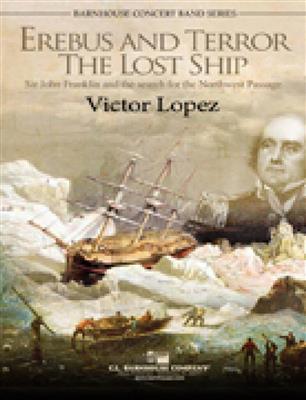Results
-
 £57.50
£57.50Between Earth and Sky - Michael Oare
Myths and legends of dragons have stirred our imaginations down through the ages. Between Earth and Sky is a programmatic work opening with mystical strains and haunting melodies. The pace quickens as our beast takes flight and soars over the countryside; musically propelled by a driving 3/4 pulse and powerful thematic statements. All beautifully paced with variations in textures and dynamics, this is an effective and appealing work for young players.
Estimated dispatch 7-14 working days
-
 £121.50
£121.50Storm And Urge - Edward Fairlie
Edward Fairlie's Storm and Urge is a significant work for wind band and portrays a journey of emotional turbulence. The title comes from the German "Sturm und Drang," a literary and musical movement of the late 1700s which focused on extremes of emotion. Opening with a simple and reflective theme, we are then taken through a range of emotional settings from uncertainty to resistance, and then calm resolve and self-knowledge. With a variety of textures and vivid imagery, this is a masterful work for the contemporary ensemble.
Estimated dispatch 7-14 working days
-
 £89.99
£89.99Heroes Near and Far - Richard L. Saucedo
Each of the five movements of this innovative work is designed to invoke a particular type of emotion associated with leadership. Courage is stately in nature and written in a marcato style. Vision is playful in character andfocuses on mixed meters as well as mixed emotions. The lyrical and sensitive Compassion is meant to stir the soul, while the contrasting Selflessness offers some of the most intense and demanding music of the set. The energeticfinal movement Heroes will bring to mind your own favorite superhero! Educator and speaker Scott Lang helped develop the concept for this unique work, and has made available supplemental curricula centered around leadership andcharacter development. This material is tied to the Common Core Standards relating to reading, writing, music, art, and critical thinking. Each movement and its accompanying curriculum can stand on its own, allowing the directorthe flexibility of using as much or as little as desired. A tremendous resource for today's teacher! Dur: 9:20 Accompanying curricula and materials available at www.scottlang.net
Estimated dispatch 7-14 working days
-
 £56.99
£56.99Courtly Procession And Dances - Rebecca Jarvis
"Courtly Procession and Dances" brings the royal courts of medieval Europe to life at your next concert! The work opens with a stately brass and percussion fanfare. The courtly procession follows, and is played by the full ensemble. A slower, lyrical dance contrasts with the procession and eventually leads into a light-hearted and lively dance featuring very playable woodwind lines. The work concludes with a restatement of the processional. "Courtly Procession and Dances" is fresh, highly melodic, and great for variety in concert programming.
Estimated dispatch 7-14 working days
-
 £80.99
£80.99Erebus and Terror: The Lost Ships - Victor Lopez
This Victor Lpez work evokes images of excitement, bravery and sorrow as "Erebus and Terror: The Lost Ships" retells the story of the Sir John Franklin expedition in search of the Northwest Passage. Beginning with anticipation as the explorers depart their homeland, the rousing melodic theme is written for clarinet, horn and alto saxophone. The excitement of the journey turns melancholic for a few moments, as the gravity of their journey sinks in, but their courage is again renewed as the trumpets tell the story. A haunting flute and oboe duet foreshadows the inevitable crash portrayed with strong chromatic dissonances, into the ice and the loss of both ships and their crews. The journey has ended for these men, but their story lives on and Sir John Franklin is remembered as a hero due to his valuable contributions to the development of Canada's north. Highly recommended!
Estimated dispatch 7-14 working days
-
£86.50
The River And The Rock - David Shaffer
"The River and the Rock" depicts the rich history of Fitchburg, Massachusetts, settled in 1735. Each short movement paints a musical picture of the city's history, opening with "Beginnings," depicting a frontier that was settled very slowly as hostilities between England and France encouraged Indian bounty hunters to attack isolated garrisons in the region. "Patriots" suggests the city's call to arms throughout history. "Prosperity" visits the industrial revolution and the city's rapid growth at the turn of the 20th century. Movement IV and V, "Decline" and "Revival," offer a musical insight into the city's decline throughout the 20th century and rebirth in the 21st century. Exciting and emotional, "The River and the Rock" merges history and music into a setting that your students will enjoy preparing. Excellent selection for festivals and contests!
Estimated dispatch 7-14 working days
-
£53.99
Witches And Wizards - Shaffer
Listen, if you dare, as the witches concoct a kooky and mysterious melody of the macabre! Wizards engage in a diatonic discourse of delightful and delicate dissonance. The magic of "Witches and Wizards" will engage your inner spirits as a picture of mystery and mayhem is painted. Craftily written and arranged for the younger musicians, "Witches and Wizards" is sure to be the eerie and mystical hit of any concert!
Estimated dispatch 7-14 working days
-
£60.50
Christmas Bells And Brass - Larry Neeck
Get your band into the holiday spirit with this unique and very playable work! Carols included are "O Come All Ye Faithful," "Deck The Halls," "Silent Night," and "Jingle Bells". You will find this unique arrangement musically and educationally satisfying, and this Build-A-Band edition is perfect for those ensembles with incomplete or awkward instrumentations. An excellent choice for your next holiday concert, "Christmas Bells and Brass" will appeal to audience and band members alike, and your band will sound like gold!
Estimated dispatch 7-14 working days
-
£98.50
To Protect And Serve - Robert W. Smith
Suite for the Heroes Among Us is a musical tribute from master composer Robert W. Smith to the everyday heroes that dedicate their lives to the care and protection of us all. The third movement To Protect And Serve isdedicated to the law enforcement professionals that serve our communities each and every day. This bold and powerful musical statement is appropriate for concert, festival and ceremonial use throughout the year. Combined with Fire and Heal (Mvts. 1 and 2), Suite for the Heroes Among Us is programmable and appropriate in every community in the world.
Estimated dispatch 7-14 working days
-
 £149.99
£149.99Heaven and Earth - Jan Bosveld
An Astrological Composition. Astrology is based on the principle that each sort of time has its own quality. In order to determine the quality of a particular moment, an astrologer looks at the position of the planets in the solar sustemat that moment. Each planet has specific types of energies and its location provides unique information for a certain moment on Earth. Thus: its position in the sky tells something about what happens on Earth. In this composition the typesof energies of four planets are musically translated. The four planet were not randomly chosen. There are two pairs, whose influence and energy are opposite. Venus and Mars. Venus represents the feminine principle: harmony, beauty,art, and the ability to make relationships and to keep the peace. Venus connects, and communicates in order to maintain the balance. Mars represent the masculine principle: winning, impulsiveness, enthusiasm, and sexual energy for procreation.He creates war enabling the strongest to triumph. Mars is musically depicted in a stirring march in which enthusiasm characterises the masculine character. Saturn and Jupiter. Saturn represents concentration and withdrawal: the strongnotion of responsibility, seriousness, self-discipline and melancholy. Saturn is the hermit who will conquer his fears and worries in minimal conditions and by self-chastisement. This contemplative character is depicted in the music as if it isalmost standing still, which also reflects the given character of this planet. Jupiter represents growth and expansion: the positive, self-confidence, the good Samaritan, the healer. Jupiter is the philosopher who will make the world a betterplace, sees future possibilities, and searches for eternal values. He is the prophet who sometimes rants and raves his doctrine and proclamations, resulting musically in a whirling and upbeat finale. not looking back at what has been but searchingfor new challenges. "Heaven and Earth" was commisioned by the Music Lending and Information Centre (MUI), a department of the library for the province of Gelderland in Arnhem, The Netherlands.Een astrologische compositie. Astrologie is gebaseerd op het principe dat elke tijd zijn eigen kwaliteit heeft. ""Tijd voor koffie"" of ""het was je tijd nog niet"" als bijvoorbeeld een baan aan je neus voorbij is gegaan. Om de kwaliteit van een moment te lezen kijkt deastroloog naar de stand van de planeten in ons zonnestelsel op dat tijdstip. Elke planeet heeft specifieke energien en de plaats aan de hemel geeft unieke informatie over een bepaald moment op aarde. Oftewel: de stand aan de hemel (Ouranos) verteltiets over wat er op aarde (Gaia) gebeurt. In deze compositie worden de energien van vier planeten muzikaal vertaald. De vier planeten zijn niet lukraak gekozen. Het zijn twee paren, die qua invloed en energie tegenovergesteldzijn. Venus en Mars. Venus vertegenwoordigt het vrouwelijke principe: harmonieus, schoonheid, de kunst, het vermogen om verbindingen aan te gaan en de vrede te bewaren. Venus geeft door en verbindt om de balans te bewaren. Marsvertegenwoordigt het mannelijke principe: winnen, anderen aftroeven, impulsief en enthousiast, seksuele energie voor de voortplanting. Mars creert oorlog om de sterkste te laten zegevieren. Venus staat tot Mars als vrede staat tot oorlog, alsverbinden staat tot verbreken, als harmonie staat tot competitie. Jupiter en Saturnus. Jupiter vertegenwoordigt groei en expansie: het positieve zelfvertrouwen, de weldoener, de genezer. Jupiter is de filosoof die de wereld wilverbeteren, vooruitkijkend en zoekend naar eeuwige waarden, de profeet die soms al te bombastisch zijn leer verkondigt. Saturnus vertegenwoordigt concentratie en inkrimping: het sterke verantwoordelijkheidsbesef, soberheid, zelfdiscipline enmelancholie. Saturnus is de kluizenaar die onder minimale voorwaarden en zelfkastijding zijn angsten wil overwinnen. De harde, serieuze werker die volgens vaste regels stug doorgaat om aan zijn hoge eisen te voldoen. Jupiter staat tot Saturnusals uitbreiding staat tot inkrimping, als zelfvertrouwen staat tot faalangst, als vrijheid staat tot structuur.
Estimated dispatch 7-14 working days
